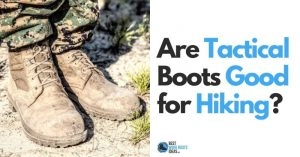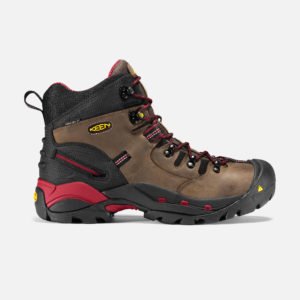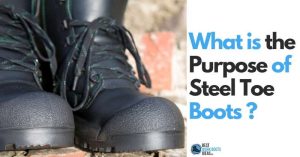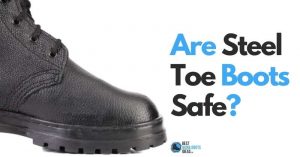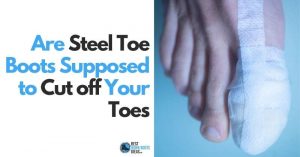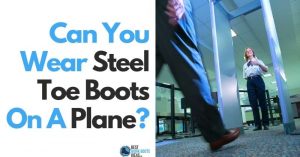Are Steel Toe Boots Good For Hiking? To buy new or use existing boots?
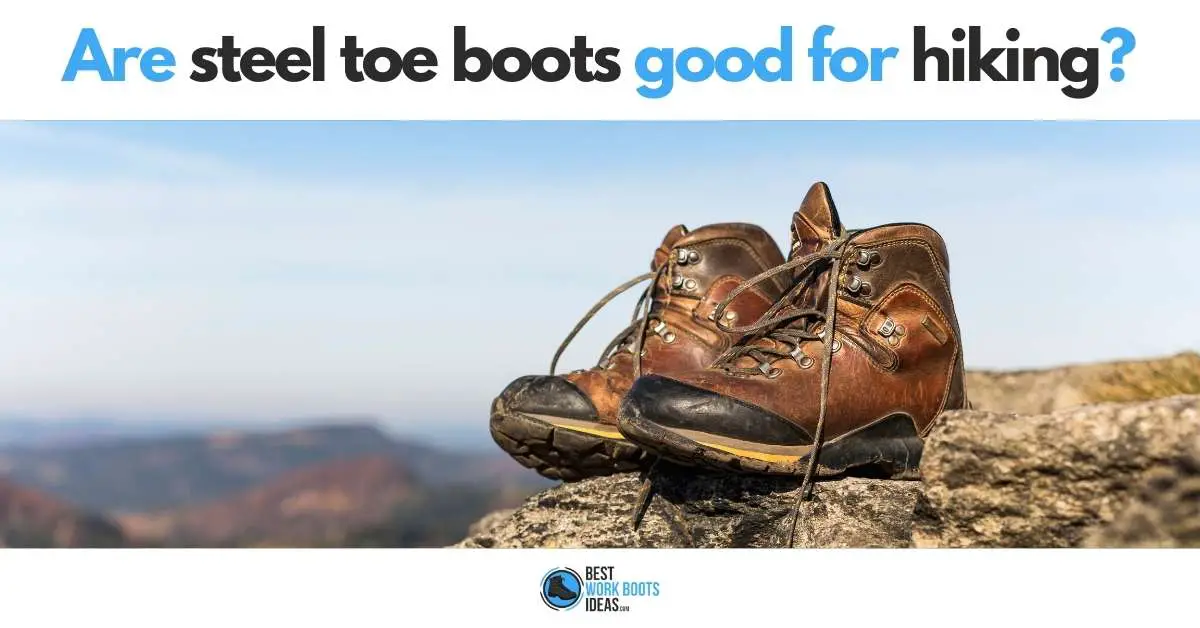
It often happens that you or a friend decide that it’s a good day for a hike, and as you look down at your shoe rack you’ve probably wondered:
Do I actually need to go to the store to pick up a pair of hiking boots or are steel toe boots good for hiking? .
While by no means am I a hiking enthusiast or expert, I do enjoy going for a hike, and it was a big part of what I did as a kid and adolescent.
I’ve gone well prepared with shoes made for the purpose, and I’ve also gotten out of work with my boots on and driven over to join my friends without being the slightest bit prepared.
While sitting down to write this article, I reflected on the times I’ve hiked trails I thought would prove too difficult for me, as well as times I’ve pulled stupid manuevers and ended up hurting myself.
I also looked through academic articles studying the effect of different variables on the body in a number of ways.
There is no shortage of academics studying topics you would never have imagined.
I always enjoy the experience of hiking, but just like at work, there are differences when you go with the tools designed for the task or go with whatever was convenient for you to bring.
Unlike the human world, nature tends to create rules for which there are no work-arounds.
It’s best to pay nature its due respect. In that spirit, let’s get into figuring out if steel toe boots are good for hiking.
Contents
The Answer Is…
No, steel toe boots are not good for hiking.
Yes, you’ll be fine if you’re going for a quick hike and you use your steel toe shoes.
I’m not trying to suggest to anyone that their feet will explode or anything like that, but there are differences between steel toe boots and hiking boots that become apparent with experience.
If you’re going to be taking hikes regularly, or even a handful of times a year, I highly advise you invest in a proper pair of hiking boots.
There are a number of reasons that hiking boots exist, and we’ll go through the differences between steel toe work boots and hiking boots that can be demonstrated with their construction.
Weight
Steel toe boots will be heavier, tiring you out more quickly.
Mathematically, your feet and legs will have lifted a substantially larger amount of weight by the day’s end with a 4lb+ steel toe boot than a 2-3lb hiking boot.
Studies have been done that show your body actually uses comparatively more oxygen per 100g of increased weight to your boots than to something you’re carrying on your back.
Additionally, the introduction of a graded surface increases the strain on your body and oxygen consumption.
It may not seem like a big deal to wear heavier boots, as you’re probably wearing heavier boots while at work.
The difference will become apparent every moment you’re walking on an incline or decline, which is likely to be the majority of your hike.
Inclines will require you to lift your leg higher than you ever do while walking normally, so you’ll be asking more of your muscles.
Declines, on the other hand, will require your foot to step down harder than your normal stride to prevent you from falling and tumbling forward.
Not to mention your foot potentially hitting the toe box area.
In all examples, heavier steel toe boots inherently ask more of your body that would be asked by lighter hiking boots.
Flexibility
Steel toe boots don’t provide the type of flexibility you’ll need from boots while you’re hiking.
This is not in only one aspect, but in a number of ways.
It’s true that steel toe boots can be made without using welt-construction methods, but there’s definitely a good chance that your steel toe boots have outsoles attached with a welt-construction method.
This makes them more durable, longer lasting, but not as flexible.
The purpose of steel toe boots is to keep you protected from injury at work, so the materials used to build them are thick and hearty.
Most steel toe boots are made using full-grain leather, a great material for stability and durability, but not the best for flexibility.
The stiffness of the material along with how much compression and stress you’ll put on your feet during a hike can end up causing neuropraxias (numbness, tingling) that will make your experience less than enjoyable.
The physical shape of steel toe boots is also different than that of hiking boots.
The throat of the boot (the part from your ankle going up the calf) is desirable at work when you’re trying to prevent the ankle from bending.
This is also known as having good ankle support.
On trails you’re going to need the full range of motion your ankle can provide.
Hiking boots are designed with little or no throat that allows to step off rocks, roots, and ditches that you won’t normally encounter somewhere steel toe boots would be required or advisable.
Full disclosure, as a residential contractor I had a pair of hiking boots for jobs that would require me to get on roofs and ladders because of that need for flexibility.
I also know union workers that buck the OSHA regulations and wear hiking boots when the day requires extra flexibility.
Breathability
Steel toe boots don’t provide the level of breathability you’ll want from your boots on a hike.
Yes, it’s possible that your boots have a moisture-wicking liner, but this is nothing compared to the mesh uppers that most hiking boots feature.
The breathability comparison between steel toe boots and hiking boots isn’t even close.
You sweat while at work, but you really sweat while hiking.
There is a level of exertion that comes from hiking that’s only really comparable to running.
All the muscles in your feet and legs are actively engaged helping you keep your balance on uneven terrain.
If you’re hiking a challenging trail you’re going to sweat.
If you try to do it in steel toe boots it’s going to feel like there’s a foot warmer inside your boot before you’ve gotten very far down the path.
In addition to the discomfort you’ll experience, you’ll be stinking up your work boots and putting serious odor mileage on them that could shorten their lifespan.
Steel toe boots simply don’t provide the type of breathability that someone would want from their boots while hiking.
Traction
The outsoles of most steel toe work boots are not designed for the type of terrain you’ll encounter while hiking.
I put this point last because there’s someone out there with steel toe boots made for lumberjacking that have a tread pattern perfect for hiking.
I don’t want to speak in generalities without acknowledging there are some exceptions, there are some exceptions on this point.
All that said, the outsoles and tread pattern found on most steel toe boots are going to be of mixed purpose, and not designed for what you need while hiking.
Most modern work boots are slip resistant, meaning that the outsoles and tread patterns are designed in such a way that they make a good amount of contact with a flat surface like tile or pavement.
They have a tread, but design assumes there’s a good amount of time you’re inside or on flat ground.
What you need from the outsoles of your boots while hiking is a pattern that really grabs onto whatever your feet land upon, regardless of pitch or flatness.
Hiking shoes, by contrast, feature deep and hearty lugs that are ill advised on flat surfaces, but perfect for irregular terrain where you need your outsoles to really grab at the earth so you can stay standing as you trek up or down a trail.
The traction provided by most steel toe boots is great on a number of surfaces, but hiking trails are not among that list.
I wouldn’t recommend anyone grab their steel toe boots if they were walking up a trail with me.
The Big Picture
Steel toe boots are great for a lot of activities, but hiking is not one of them.
You’re not gonna roll over and die if you choose to use them for a hike every now and then, but if hiking is something you enjoy, I highly recommend looking into a pair of hiking boots.
The Timberland Men’s White Ledge Boot and Keen Pittsburgh are good options when it comes to protective footwear that may be considered for hiking.
Your feet will thank you, I promise.

